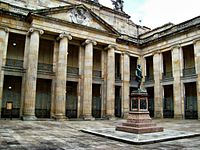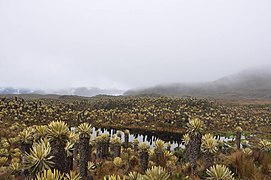Ceneria: Difference between revisions
No edit summary |
|||
| Line 27: | Line 27: | ||
|alt_map2 = <!--alt text for second map--> | |alt_map2 = <!--alt text for second map--> | ||
|map_caption2 = <!--Caption to place below second map--> | |map_caption2 = <!--Caption to place below second map--> | ||
|capital = [[ | |capital = [[Buona Via]] | ||
|coordinates = <!-- Coordinates for capital, using {{tl|coord}} --> | |coordinates = <!-- Coordinates for capital, using {{tl|coord}} --> | ||
|largest_city = [[ | |largest_city = [[Buona Via]] | ||
|largest_settlement_type = Largest city | |largest_settlement_type = Largest city | ||
|largest_settlement = <!--Name of largest settlement--> | |largest_settlement = <!--Name of largest settlement--> | ||
| Line 127: | Line 127: | ||
|footnotes = <!--For any generic non-numbered footnotes--> | |footnotes = <!--For any generic non-numbered footnotes--> | ||
}} | }} | ||
'''Ceneria''', officially the '''Cenerian Congressional Republic''' ({{wp|Italian language|Vespasian}}: Repubblica Congressuale Ceneriana), is a country in [[Asteria Inferior]]. It borders [[Gapolania]] to the north, [[Arbolada]] to the south | '''Ceneria''', officially the '''Cenerian Congressional Republic''' ({{wp|Italian language|Vespasian}}: Repubblica Congressuale Ceneriana), is a country in [[Asteria Inferior]]. It borders [[Gapolania]] to the north, [[Arbolada]] to the south. It's eastern coastline is located along the [[Arucian Sea]]. The country is divided into 14 Departments (''Dipartimento''), the capitol city of Ceneria is [[Salviaggi]]. | ||
The land of Ceneria was originally settled by the {{wp|Mapuche people|Chanuche}} people in the north and the {{wp|Toba Qom people|Aiate}} peoples in the south, here they settled in the valleys and coastline of Ceneria. It would eventually be colonized by Vespasian colonists, around the modern-day city of [[San Giorgio]] was where the first and largest colony initially was. The colony eventually became known as the colony of [[Sangiorgia]], where it would grow from there, other major cities such as [[ | The land of Ceneria was originally settled by the {{wp|Mapuche people|Chanuche}} people in the north and the {{wp|Toba Qom people|Aiate}} peoples in the south, here they settled in the valleys and coastline of Ceneria. It would eventually be colonized by Vespasian colonists, around the modern-day city of [[San Giorgio]] was where the first and largest colony initially was. The colony eventually became known as the colony of [[Sangiorgia]], where it would grow from there, other major cities such as [[Buona Via]] and [[Terza]]. | ||
Whilst it remained a part of the [[Etrurian First Republic]] it eventually wanted to gain independence. The colony would join it's neighbors and declare independence, the movement for independence renamed Sangiorgia to ''Ceneria'', meaning "land of ashes", and declared independence as the Cenerian Republic lead by the leader of the independence movement, [[Clemente Michelangeli]]. During the first republic multiple military coups took place that lead to authoritarian governments throughout the 20th century, especially that of General [[Benedetto Rizzo]]. It was eventually overthrown by a revolution lead by General [[Graziano Di Mozea]] and Bishop [[Ennio Udinese]]. | Whilst it remained a part of the [[Etrurian First Republic]] it eventually wanted to gain independence. The colony would join it's neighbors and declare independence, the movement for independence renamed Sangiorgia to ''Ceneria'', meaning "land of ashes", and declared independence as the Cenerian Republic lead by the leader of the independence movement, [[Clemente Michelangeli]]. During the first republic multiple military coups took place that lead to authoritarian governments throughout the 20th century, especially that of General [[Benedetto Rizzo]]. It was eventually overthrown by a revolution lead by General [[Graziano Di Mozea]] and Bishop [[Ennio Udinese]]. | ||
| Line 218: | Line 218: | ||
===Military=== | ===Military=== | ||
===Foreign affairs=== | ===Foreign affairs=== | ||
===Subdivisions=== | ===Subdivisions=== | ||
Revision as of 04:21, 1 March 2023
Cenerian Congressional Republic Repubblica Congressuale Ceneriana (Vespasian) | |
|---|---|
| Motto: Onore e Lealtà Honor and Loyalty | |
| Anthem: Dopo le Nuvole, il Sole After the Clouds, the Sun | |
 | |
| Capital and Largest city | Buona Via |
| Official languages | Vespasian Chanuche Aiate |
| Ethnic groups | 52% Mixed (Mista) 40% Euclean 5% Native 2% Bahian 1% Other |
| Demonym(s) | Cenerian |
| Government | |
• President | Pasquale Spezzano |
• Vice President | Amelia Lucchese |
| Legislature | Cenerian National Congress |
| Establishment | |
• Establishment of the Cenerian Republic | December 24 1794 |
| Population | |
• 2020 estimate | 22,093,319 |
| Gini (2020) | 40.2 medium |
| HDI (2020) | 0.787 high |
| Currency | Cenerian moneta (CEM) |
| Internet TLD | .ce |
Ceneria, officially the Cenerian Congressional Republic (Vespasian: Repubblica Congressuale Ceneriana), is a country in Asteria Inferior. It borders Gapolania to the north, Arbolada to the south. It's eastern coastline is located along the Arucian Sea. The country is divided into 14 Departments (Dipartimento), the capitol city of Ceneria is Salviaggi.
The land of Ceneria was originally settled by the Chanuche people in the north and the Aiate peoples in the south, here they settled in the valleys and coastline of Ceneria. It would eventually be colonized by Vespasian colonists, around the modern-day city of San Giorgio was where the first and largest colony initially was. The colony eventually became known as the colony of Sangiorgia, where it would grow from there, other major cities such as Buona Via and Terza.
Whilst it remained a part of the Etrurian First Republic it eventually wanted to gain independence. The colony would join it's neighbors and declare independence, the movement for independence renamed Sangiorgia to Ceneria, meaning "land of ashes", and declared independence as the Cenerian Republic lead by the leader of the independence movement, Clemente Michelangeli. During the first republic multiple military coups took place that lead to authoritarian governments throughout the 20th century, especially that of General Benedetto Rizzo. It was eventually overthrown by a revolution lead by General Graziano Di Mozea and Bishop Ennio Udinese.
The country entered a period of peace until the Great Collapse, it stayed neutral in the Great War. In the 1950s anmd 60s the rise of far-left and far-fight paramilitaries lead to the period known as Il Tumulto which ended with a far-right junta taking over in the 70s. It was eventually overthrown in 1980, left-wing rebels still existed until 1990 when a new constitution was adopted.
Today the Red Revolutionary Labour Party is the largest party in the country. It is a member of the CN and ASTCOM.
Etymology
The name for "Ceneria" was originally Sangiorgia, named after the capitol colony of San Giorgio, named after Saint George, one of the patron saints of colony. The colony was eventually renamed to Ceneria when it declared independence from Etruria, to differentiate itself from Euclean rule the independence movement called for the name of the colony of Ceneria, coming from the Vespasian word Cenere, meaning ashes, named after the volcanoes in the colony.
History
Prehistory
Pre-Colonial Ceneria
Colony of Sangiorgia
Independence

19th Century
1892 Revolution
Early 20th century
- Cenerian Years of Serenity
- Great Collapse
- Great War
- Rise of the far-left and far-right
Late 20th century
- Il Tumulto
- Far-right junta
- 1981 Coup
- 1990 Peace Deal
21st Century Ceneria
- Rise of the PLRR

Geography
Climate
Biodiversity
Government
Ceneria is a Unitary Presidential republic, it's legislature is unicameral, and it is a multi-party system. There are three major branches of government in Ceneria, the executive, legislative, and judiciary.
The President serves as both head of state and head of government, they oversee the Cabinet as well as leads the party or coalition they are apart of. He is also the commander-in-chief of the Cenerian military. The current President of Ceneria is Pasquale Spezzano.
The President selects a running-mate for the position of Vice-President, who will take charge as thew second-in-line for succession of the Presidency. The Vice-President serves to advise the President on decisions and issues as well as coordinate actions between government bodies. They also serve in place of the President at times when the President is absent.
The Legislative Branch is the Cenerian National Congress, it consists of 247 seats, each representing a Congressional District in the country. It previously was a Bicameral legislature until 1990 when the new constitution changed it to a unicameral legislature. The head of the Ceneral National Congress is the President of the National Congress. Each district is equal in population are the number of districts in each Department varies depending on the population of the Department.
The judiciary of the country is the Cenerian Supreme Court, it is the highest court in the land and oversees issues pertaining the constitution of the country. There are a total of 5 members on the Supreme Court, they are elected by the National Congress and serve a two-year term of office.
Political parties
 |
|
Government (132) Red Revolutionary Labour Party (95) United Socialist Force (32) Indigenous Representation Party (4) Opposition (115) Sotirian Democratic Society (34) Liberty Party (24) National People's Party (24) Spirit of the Republic (17) Cenerian Section of the Workers' International (16) |
After the 1980 Coup that restored a democracy, the country has been in a state of multi-party system since. The original largest parties in the country were the centre-left Democratic Liberal Movement and the centre-right Cenerian Bloc. Over time new parties arose that replace the initial two parties, these included on the right the centre-right Sotirian Democratic Society, right-wing National People's Party, and the centre Liberty Party.
On the left, the largest party is the Red Revolutionary Labour Party, a left-wing nationalist party that is populist in nature. Today other left-wing parties such as the United Socialist Force, which united numerous smaller left-wing parties under one social democratic and green-based party.
Other parties include the far-right populist Spirit of the Republic, founded in 2014, which is inspired by the Tribune Movement and Popular Victory parties in Euclea. Another political party is the Indigenous Representation Party, which is a party that runs on indigenous groups' interests, created by law in 2008 under President Gloria Scutari.











